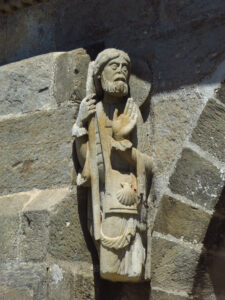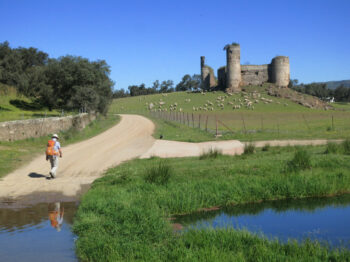St James – 27 July

By Fr Mervyn Duffy SM

A French statue of St James showing him as a pilgrim with the Compostella shell
According to the Gospels, St James was a fisherman and brother to John. One of two people named James called by Jesus to be Apostles, he was a witness of the Transfiguration and one of those who slept through most of the Agony in the Garden.
It is not really the Scriptures which have given James great fame in the Church, his impact is because of the legends that accumulated around the historical figure.
He was the first Apostle to be martyred, beheaded in the year 44. It is after his death that his story starts to get unusual.
We enter the realm of legend here. One of the great promoters of the James legend was Jacobus de Voragine. Now he was not unbiased, his name is Jacobus which is the Latin form of James, so James was his patron saint. Jacobus was the archbishop of Genoa in the thirteenth century and he put together a famous collection of saint stories called the Golden Legend. St James the Greater gets many more pages in it than most. The collection was intended as a help to preachers:
The apostle James was called James of Zebedee, James brother of John, Boanerges, i.e. son of thunder, and James the Greater. […] James is called son of thunder by reason of the thunderous sound of his preaching, which terrified the wicked, roused up the sluggish, and by its depth attracted the admiration of all. So Bede says of James “He spoke so loudly that if he thundered by a little more loudly, the whole world would not have been able to contain him.” James is called the Greater, as the other James is called the Less, first, because he was the first of the two to be called by Christ, secondly because of his intimacy with Christ, who seems to have had a closer relationship with this James than the other, admitting him to his secrets, as at the raising of the daughter of Jairus and at the Lord’s glorious transfiguration. He is called the Greater, thirdly, by reason of his glorious martyrdom. […]
James was beheaded on 25 March, the feast of the Lord’s annunciation, and was transferred to Compostella on 25 July. […] His disciples went at night, for fear of the Jews, got his body, and put it aboard a rudderless boat. Commending the burial to divine providence they set sail, an angel of the Lord being their pilot, and made port in Galicia, Spain. They landed in the realm of Queen Lupa, whose name, which means she-wolf, fitted her well. They carried the saint’s body off the boat and laid it on a large rock, and the rock promptly softened, miraculously shaping itself into a sarcophagus for the body. […]

12th Century carving of St James on the Church at Santa Marta de Tera, Zamora, Spain
The Queen said “Go and take the master’s body, and build a tomb for him wherever you choose!” This was wolfish cunning, because she knew the oxen were really wild, untamed bulls. […] But no wisdom can prevail against God. The disciples, not suspecting the queen’s ruse, went up into the mountain. A fire-breathing dragon came charging upon them, but they met him with the sign of the cross and split him up the middle. Then they made the sigh of the cross over the bulls which suddenly became gentle and submitted to the yoke. Next they put Saint James’s body, with the rock upon which they had laid it, on the wagon. The oxen, with no one guiding them, hauled the body into the middle of Lupa’s palace. This was enough for the queen. Recovering from her astonishment, she believed and became a Christian, granting everything the disciples asked for, gave her palace to be a church dedicated to Saint James, endowed it magnificently, and spent the rest of her life doing good works.
I suspect that medieval sermons were much more entertaining than modern ones. Jacobus lists dozens of miracles worked at the shrine of St James in Compostella, and then goes on to mention prayers granted miraculously when the name of James was invoked. I will give you one quick example.
A certain tyrant had unjustly despoiled a tradesman of his goods and kept him in confinement, and this man devoutly besought St James’s aid. The saint appeared while the guards looked on, and led the man to the top of the tower. The tower then bent over until the top was level with the ground, and the prisoner stepped off without jumping and went on his way. The guards went after him, but, though they passed close to him, they could not see him.

El Real de la Jara on the Way of St James - Via de la Plata variant.
Because of wonders like these, or at least the accounts of them, Compostella became the most famous pilgrimage place in Western Europe and pilgrims in their thousands still walk the Camino across Europe to the shrine of St James.
With or without the legends and the special effects, the Church puts before us today an Apostle, a friend of the Lord, as our example and intercessor.
 Entries(RSS)
Entries(RSS)